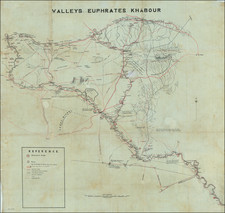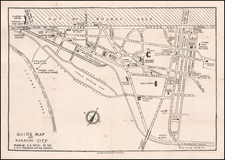The Most Influential Map of the Ottoman and Persian Empires Published in the Sixteenth Century
Rare and highly influential two-sheet map of the Ottoman and Persian Empires by Giacomo Gastaldi, one of the most celebrated Italian cartographers of the sixteenth century. It depicts Turkey, the Middle East, and Central Asia.
The present map, the first in a set of three maps of Asia produced by Gastaldi between 1559 and 1561, comprises the westernmost section of the landmass. It is bounded by the Black Sea (Mare Maggiore) and the Mediterranean in the west, with Moscow and present-day Moldova (Moldavia) to the northwest and Egypt (Egit) and the northern Red Sea to the southwest. To the east the map is bounded by Central Asia, with Gujarat (Guzarate) to the southwest and a desert, Care, likely in present-day Kyrgyzstan, to the northeast.
In the Black Sea, the Crimean Peninsula (Gazaria) juts down from the north, and Constantinople can just be seen to the southwest. South of Turkey (Natolia), the island of Cyprus is prominent in the Mediterranean.
The Caspian Sea is depicted interestingly in an oval shape, as was common until the 1730s. In the north, the Caspian is named Mare Chivaliscomoria, after the Chwalis people who had populated this area; to the south it is named Mare de Bachu, after the coastal city of Baku (in present-day Azerbaijan), an important strategic and trading power in the Persian Empire at this time. To the east the Caspian is named Mare Coruzum, after the Turkic Khwārezm-Shāh Dynasty active in this area in the Middle Ages.
Decorative elements are employed throughout the map. Both larger sailing ships and smaller vessels with many oars are depicted in each of the bodies of water. Some ships in the Black Sea have crescents on their sails, indicating the Muslim Ottoman Empire’s control of this area. Along the northern border clusters of tents are depicted on the Steppes, indicating the nomadic or semi-nomadic lifestyle of the Tatars and other neighboring peoples.
In the Caspian is also depicted a large compass rose of eight winds, a system developed by Medieval mariners on the Mediterranean. The eight wind names, shown here as initials, were expressed in an Italianate Mediterranean lingua franca primarily composed of Genoese (Ligurian) mixed with Venetian, Sicilian, Provençal, Catalan, Greek, and Arabic terms. Thus, T, or Tramontana, is north; G, or Greco, is northeast; L, or Levante, is east; S, or Scirocco, is southeast; O, or Ostro, is south; and P, or Ponente, is west. Southwest in this system would be L again, for Libeccio, but in the present map it is marked A, perhaps for Africus, the Roman name for this direction in the classical twelve-wind system.
In the top right is a large cartouche, which gives a thorough description of the map’s contents and indicates that it was produced by Antonio Lafreri (Antoine Lafréry), a French publisher based in Rome, and engraved by the Belgian Jacob Bos.
Gastaldi’s maps of Asia
As mentioned above, the present map was the first in a series of three maps of Asia by Gastaldi. While this first map was originally published in 1559, with slight differences, as Il Disegno Della Prima Parte DellAsia, the present state is from 1561, the year the second and third maps in the series were originally published. This map and the second in the series were each accompanied by a separate gazetteer listing the ancient and modern place names used, while in the third map in the series these place names were included in the map itself.
While each of the three maps were intended to be sold as separate sheets, they were sometimes bound into custom “atlases” made up for purchasers. These composite atlases are sometimes referred to as Lafreri atlases, after Antonio Lafreri, the publisher of the present map, as he was known for having gathered his prints into bound selections for collectors.
There is evidence that Gastaldi intended this series to be part of a larger set of maps of the four continents of Europe, Asia, Africa, and the Americas. However, this ambitious project was never realized.
Gastaldi’s three maps of Asia were perhaps the most influential of this region in the sixteenth century. At least three other important maps of the century were based off Gastaldi’s series: Abraham Ortelius’ 1567 map of Asia, Gerard de Jode’s 1578 map of Asia, and the ca. 1570 globe gores likely by brothers Giulio and Livio Sanuto.
Depictions of the Caspian
One noteworthy feature of the present map is its inaccurate representation of the Caspian Sea in a horizontal oval shape. This depiction originates with Ptolemy, whose world maps all show the Caspian in this oval shape. A few maps, mainly from the late fourteenth and from the fifteenth century, did show the Caspian much closer to its real shape, although not in its actual position. These include Abraham Cresques’ Catalan Atlas of 1375 and the Fra Mauro world map of ca. 1450.
However, for the most part, most European maps continued to depict the Caspian in this distinct oval shape until the 1720s and 1730s. Finally, thanks to Russian charting of the Caspian completed by navy officer Karl van Verden in 1720, more accurate depictions of the sea began to appear in maps. Some early examples based on these new surveys include Johann Baptist Homann’s Geographica Nova ex Oriente Gratiosissima (1725) and Matthäus Seutter’s Magni Turcarum Dominatoris Imperium… (1730).
This is just one of many fascinating details in this scarce and striking map, perhaps the single most influential map of the region published in the sixteenth century.
Rarity
This map is very rare on the market. We have only ever featured it once in over two decades.
Giacomo Gastaldi (1500-1566) is considered the foremost Italian cartographer of the sixteenth century, alongside Paolo Forlani. His skills of compilation are comparable to those of Mercator and Ortelius, yet much less is known of his life than of his two contemporaries. Gastaldi was born in Villafranca, Piedmont, but had established himself in Venice by 1539. He originally worked as an engineer, but turned to mapmaking from the 1540s onward.
It was in Venice where he made his reputation as an engraver, geographer, and cosmographer; for example, he was asked to fresco maps of Asia and Africa in the Palace of the Doge, or the Council of Ten, Venice’s governmental body. He also frequently consulted on projects for the Savi sopra la Laguna, drawing maps for this body which oversaw the regulation of fresh and salt water around Venice.
His contemporaries also recognized his skill, as he was named cosmographer to the Republic of Venice, was a member of the Accademia Veneziana, and was a major source for other geographers and mapmakers including Camocio, Bertelli, Cock, Luchini, and Ortelius. He even had his own distinct style of copper engraving that made him a pioneer in his day and makes his works iconic today.
Gastaldi enjoyed an especially productive relationship with Giovanni Battista Ramusio, Secretary of the Venetian Senate, who used Gastaldi's maps for his famous travel account collection, Navigationi et Viaggi. Gastaldi also tutored Ramusio's son in cosmography.










![[The Most Outstanding Mosque of Turkish Kaeysers Solimans, in Constantinople] Die ueberausspraechtige Mosque des Tuerckischen Kaeysers Solimans, in Constantinopel](https://storage.googleapis.com/raremaps/img/small/94475.jpg)
![(Nuremberg Chronicle) [Saul and Odysseus]](https://storage.googleapis.com/raremaps/img/small/98684.jpg)
![Geografia degli Ebrei o Divisione de' Popoli secondo il Sistema Biblico [Geography of the Jews or Division of Peoples according to the Biblical System]](https://storage.googleapis.com/raremaps/img/small/87430.jpg)
![Plan du Typa ou de Macao [with] Plan De La Baye D'Awatwska…Du Kamtschatka [with] Parti Du Japon ou Nipon](https://storage.googleapis.com/raremaps/img/small/36150.jpg)
